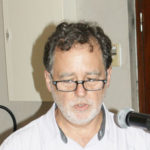M J Tuca, A Garín, J Valderrama, C Mellado, G Ferrer, G Espinoza (Santiogo, Chili)
Objectives: propose a score that allows us to predict the healing potential of high-grade medial-sided knee injuries (HGMSKI).
Methods: Retrospective study of 40 consecutive HGMSKI. Inclusion criteria: (1) HGMSKI confirmed by Magnetic Resonance Imaging (MRI) performed acutely following injury (< 2 weeks) proving a complete rupture of medial collateral ligament (MCL), (2) follow-up > 8 weeks. Conservative treatment was indicated in all cases, consisting of knee brace and partial weight bearing for 8 weeks. “Controls” where all those patients in which conservative treatment successfully reestablished medial stability, and cases where those that still had medial knee instability at physical examination and valgus stress x-rays.
We propose a score that designated 1 point for each of the following: (1) high-energy injury (2) concomitant ACL or (3) PCL tear (4) valgus stress test >10mm at 0° (5) or >10mm at 30° (6) absence of the posterior oblique ligament (POL) in the axial MRI views (7) Gap >10mm between MCL and medial femoral condyle in the coronal MRI views.
Results: sample consisted of 16 cases and 24 controls. Application of the score to both groups resulted in 5,1 points average (3–7) for the Cases, and 2,3 points average (0–4) for the Control Group. Logistic regression showed a cut-off point, to discriminate between both groups, of 4 points (Sensitivity 87,5%, Specificity 83,3%, PPV 77,8%, NPV 90,9%).
Conclusion: the score proposed in this study allows to estimate with a high probability that those HGMSKI counting more than 4 points will fail conservative treatment.


